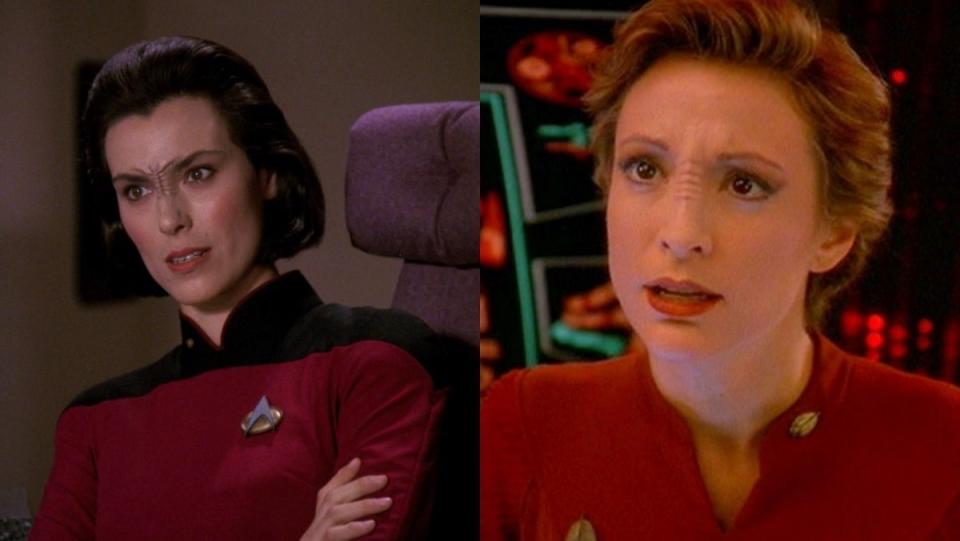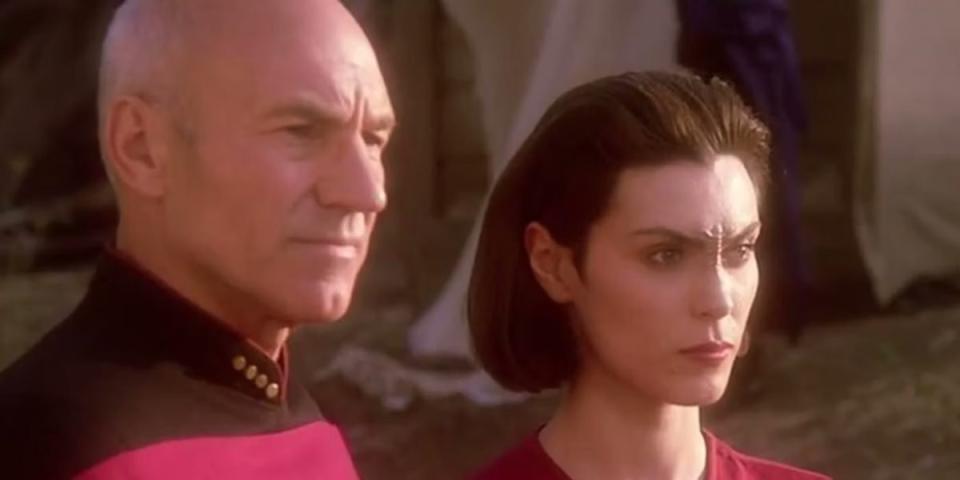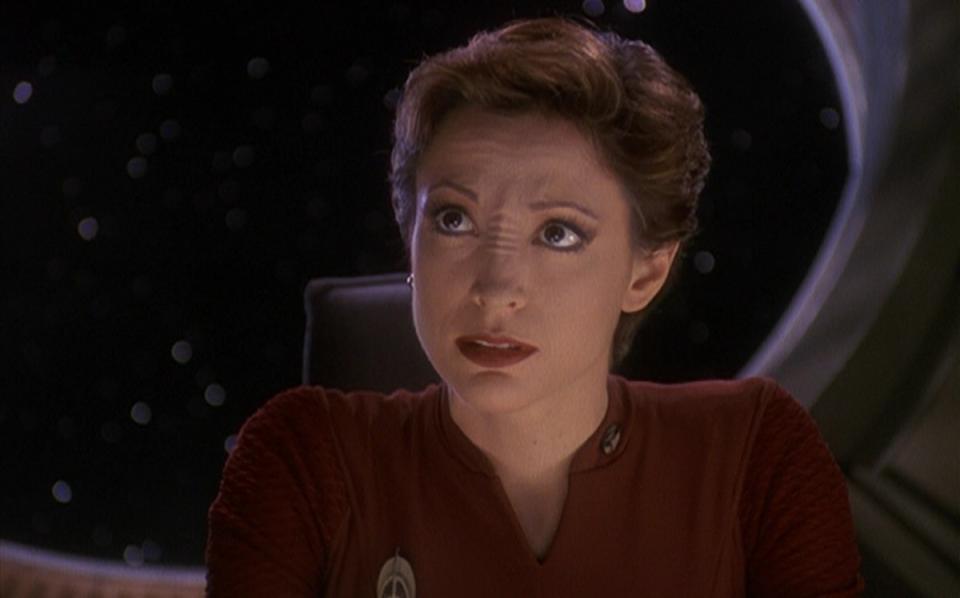STAR TREK: PICARD and the Franchise’s History of Strong Bajoran Women
After its first two seasons deliberately stayed away from involving the much-loved cast of Star Trek: The Next Generation, season three of Picard has finally embraced its roots as a legacy series. The show has dipped into TNG’s expansive pool of talent to fill its ensemble. But where previous episodes have introduced major TNG players like Geordi, Riker, and Worf, this week’s episode, “Imposters”, features the return of an unlikely but undeniable fan favorite: Michelle Forbes’ Ro Laren. Ro’s momentous return marks a series high for Picard. It serves as not only a testament to the power of Forbes’ performance, but also a reminder of how Bajoran women serve as necessary disruptors in the Trek universe.

Two shows in the Trek franchise have prominently featured a Bajoran woman in the main or recurring cast: Deep Space Nine with Nana Visitor’s Kira Nerys, and, of course, The Next Generation, who introduced us to the strength of Bajoran women with the fiery, unflinching Ro Laren. Though both Ro and Kira are ‘good guys’, and allied with Starfleet, it quickly becomes clear on both shows that just because they work with Starfleet officers, they don’t always agree with or even like Starfleet.
While it may be easy to forget when so much of Star Trek’s current programming explores ideas of corruption within the Federation itself, the idea that Gene Rodenberry’s Utopian alliance of planets might be anything other than entirely morally upstanding was once taboo and blasphemous in the Trek universe. Challenging the position of Starfleet as heroes was a risky move for the fledgling Next Generation. One of the first characters to truly provide a moral challenge to Picard, Riker and their blind loyalty to and belief in was undoubtedly Ro.

Introduced in an episode fittingly titled “Ensign Ro”, we first meet the Bajoran freedom fighter as a lowly ensign assigned to visit the Enterprise-D to assist with locating a group of terrorists. Both Picard and Riker immediately vocally protest this assignment, citing previously clashes with Ro. It’s rare that we see Picard—a Captain perhaps most famous for his level-headedness and cerebral nature—express such blatant disdain for a member of Starfleet. It quickly becomes clear that the tensions between Ro and Picard/Riker are more than reciprocated.
One of the first true anti-heroes of the Star Trek franchise, Ro undergoes a fascinating arc. Initially a reluctant rebel-hunter, then Maquis defectee, she embraces her Bajoran heritage and decides to take up the rebellion against the oppressive Cardassian regime. Ro herself is an electric, scene-stealing character and a welcome addition to virtually any episode. But what’s most memorable about her is how she challenges Riker and Picard in their attitude and frame of thought about Starfleet’s morality.

Though perhaps not as sympathetic towards Bajor as Deep Space Nine would later be, The Next Generation takes the cause of the Maquis and the plight of the Bajoran people seriously. This comes not just from writing the Maquis off as villains-of-the-week or turning Bajor into yet another small planet for Starfleet to rescue. Instead, Bajor and its people resist Starfleet involvement. They often find themselves in direct opposition of Enterprise-D missions. Time and again, Ro flat-out tells Picard and Riker that her personal beliefs and cultural identity put her at odds with Starfleet’s agenda. In turn, this causes Picard to reluctantly reexamine his position on the issue when he must conflict with another officer.
It’s also through Ro’s turn on The Next Generation that we indirectly get Deep Space Nine’s fearsome first officer Kira Nerys. Another fan-favorite, this time a series regular and an undoubtedly more empathetic (but no less strong-willed) Bajoran woman with ties to the Maquis rebellion. Though the writers initially created the character as replacement for Ro, Kira quickly becomes one of Deep Space Nine’s core players and a fascinating character in her own right.

Where Ro introduced the presence of Bajor as a small but strong people willing to go to any means necessary to dislodge the brutal military occupation of Cardassia, Kira was the portrait of a seasoned veteran who had achieved something of a shaky victory. Ro joins the Maquis after some tossing and turning; Kira already got her hands bloody in the occupation when the show introduces her.
But instead of a warmongering veteran or a violent freedom fighter walking the line towards “terrorist” (a dynamic acknowledged in the Deep Space Nine documentary as uniquely pre-9/11), Kira Nerys is a warm, welcome presence in the series. She brings heart and humor along with her stubbornness and now customary Bajoran strength. Though they may share more than a few traits in terms of physical appearance (a brown bob, nose ridges, red uniform, and of course, the earring) they represent the growth of the series’ attitude toward and interest in Bajor as a planet.

By the time Deep Space Nine entered its later seasons, Bajor itself had the opportunity to develop and explore darker, messier facets of its history—in particular surrounding their religious beliefs and leaders exemplified in Kai Winn, the first elected Kai of Bajor post-Cardassian occupation and an orthodox believer in the Prophets. Through Kira, Bajor receives the same kind of introspection that Starfleet explores via Ro in The Next Generation. It’s yet another oxymoronic similarity between the trajectories of Ro Laren and Kira Nerys during their Star Trek tenures.
With the return of Ro Laren in “Imposters,” audiences are once again reminded of the fiery, scene-stealing strength of Bajoran women in Star Trek. They are not just heroes to root for, but morally and ethically complex freedom fighters whose oppression and subsequent battle for independence has crafted a crop of deeply complex characters. In Bajoran women, Star Trek finds some of its most memorable characters and compelling episodes—a torch carried by Picard’s most recent entry.